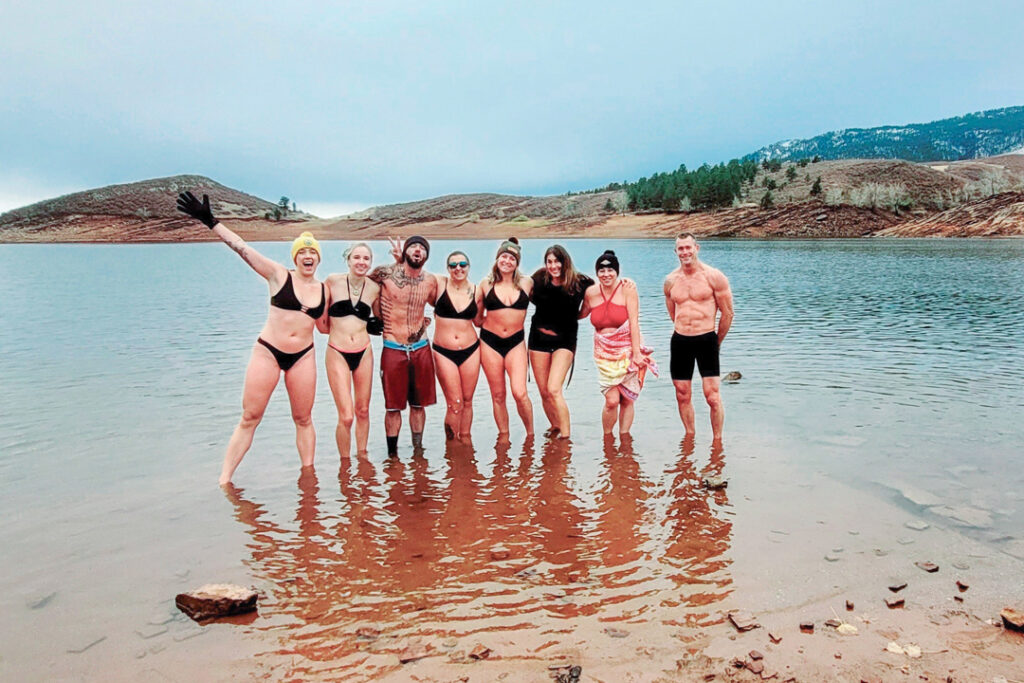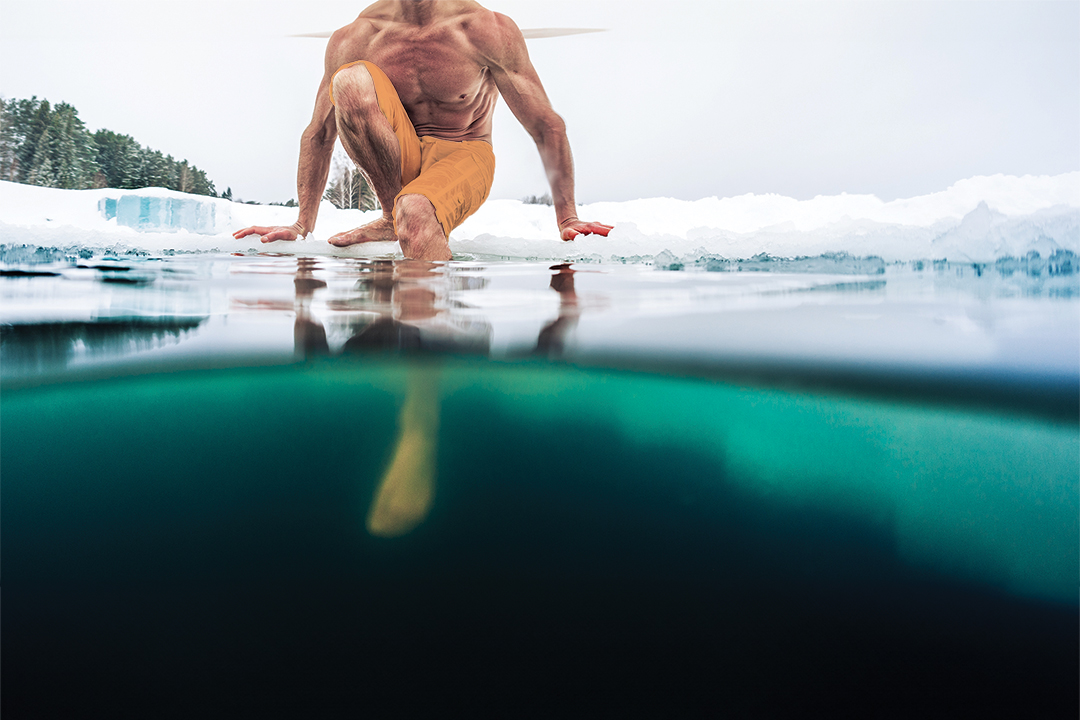Yulia Avdeyeva is used to people saying she’s lost her mind. Normal people, she says, don’t understand why she would spend a portion of her weekend plunging into Horsetooth Reservoir’s icy water.
“People who are normal don’t come to cold plunges,” she says.
She laughs after she makes this comment, but she’s not joking. She once suffered from crushing depression and anxiety. She tried ultrarunning as a way to help her control both, but she jumped to a 100-mile race way too fast and, literally, ran her knee into the ground.
Now she gathers a group every Saturday and Sunday at the reservoir and takes a dip in water that’s near or below freezing. Sometimes it’s cold enough to trigger muscle spams, and newbies occasionally pass out upon entering the reservoir or puke as they exit. That’s why, if rangers see you plunging alone, they kick you out, she says.
Avdeyeva says cold plunging solved her mental health issues and has helped with her arthritis since she began doing it in 2020. Many in her group of 40 or so regulars say the same thing, as do some of the approximately 200 people who have passed through her informal organization. She started the Northern Colorado Cold Plungers page on Instagram just so that she’d have company during her plunges.
“I did it to heal my body, and it blew up into a group,” she says. “Now we call it a suffer fest, but we do it together.”

Yulia Avdeyeva (fourth from left) with the Northern Colorado Cold Plungers at Horsetooth Reservoir.
Many plungers prefer Horsetooth Reservoir, but others will use the river—the Poudre River Whitewater Park near downtown Fort Collins is a popular spot—or purchase a cold tub. Another option is, of course, filling your bathtub with cold water and putting ice cubes in it.
Boutique fitness clubs have caught on to the trend, and even longstanding gyms have cold water tubs now. Green Events, a Fort Collins business that puts on races such as the Equinox Half Marathon & 5K, has hosted the Polar Bear Run & Plunge at Horsetooth Reservoir every January for a decade.
Even medical leaders such as the Mayo Clinic recognize that there appears to be benefits to cold plunging. Research shows that icy water may reduce inflammation after exercise, build resiliency and “improve cognitive function and mood,” according to an article on the Mayo Clinic’s website.
The article also points out the dangers, including frostbite and hypothermia, and that cold water can hinder progress after exercise because it doesn’t allow the body to adapt and get stronger. Avdeyeva says cold water can worsen symptoms of certain types of arthritis, though it has benefited her.
Avdeyeva does not call herself an expert, but she is experienced enough to offer advice and know many of the tricks that have helped her get through a cold plunge. She plunges three to five times a week, with friends at Horsetooth on the weekends and in her own personal cold tub during the week. She feels what she calls “happy hormones” coursing through her body after she’s through. She can’t say it will work for everyone, but she knows it works for her.
Progress through the plunge
One of the slogans at Reps & Restore, a fitness studio that opened in Fort Collins in June, is “embrace the discomfort.” Good work in the gym isn’t comfortable, says owner Dom Campana, but embracing that fact is important for progress. The cold tub at the gym is a big part of that.
“It’s not just lifting weights,” Campana says. “It’s important to be mentally strong.”
This is why Avdeyeva and the Mayo Clinic say cold plunging builds resiliency; it teaches your brain to embrace discomfort. Avdeyeva says the second time a person joins a plunge at the reservoir is harder than the first because they know what’s coming. But after a while, they get used to it.
One of the cooler things about cold plunging, Campana says, is that it seems to help with autoimmune diseases such as multiple sclerosis. His mother has MS, which can sometimes be controlled by diet and exercise, and plunging has also helped her, he says. Other gym members seem to love it as a result of the “happy hormones” Avdeyeva feels when she gets out of the water.
“You should see their faces when they come out of the room,” Campana says. “They have a big smile on their face. They just got hit with so many endorphins.”
One traditional gym that has embraced the trend is Work Out West in Greeley, which has been around for decades but recently introduced a cold tub as part of a new emphasis on recovery. They’ve also brought in massage chairs and a red light therapy bed.
“Part of going to the gym is tearing your muscles down,” says Sean Casten, director of operations at Work Out West. “We take the recovery side as seriously as the building side.”
Work Out West sells a platinum membership that includes unlimited use of the cold tub (many gyms charge separately for this), and Casten says those memberships have sold well almost exclusively because of the cold tub. A group of members 60 and older use the gym early in the morning, he says, and all of them use the cold tub.
“They all say their joints feel more mobile, and they’ve had less pain and stiffness,” he says.
Casten doesn’t like to oversell the medical benefits of cold plunging because he believes it’s easy to get carried away when a health trend shows promise. But he has had clients who use it for their mental health as well, especially anxiety.
“There’s some debate on all the benefits of cold plunging,” Casten says. “The one thing I don’t think there’s any doubt on is that it teaches you to breathe through the discomfort. Once you hit that cold water, you need to breathe. It is good for controlling anxiety that way.”
A plunge for fun
When Green Events founder Lisa Sinclair started the Polar Bear Run & Plunge a decade ago, the idea was to present a crazy thing for people to do and raise money for the Larimer County Dive Rescue Team, a water rescue organization made up of volunteers.
“We don’t stay in the water for any length of time,” she says.
The event, which will take place this year on Jan. 25 with an optional Polar Bear 5K, remains popular. More than 500 people do it every year.
“It’s a community thing,” Sinclair says. “There’s a real energy that surrounds it.”
The worst part of it remains true for her event as well as the cold plunging enthusiasts who soak in the freezing water instead of dashing in and out of it.
“It’s the anticipation of going into the water,” she says. “Once they do it, there’s a huge thrill.”
Sinclair has done cold plunges herself, but she’s not an expert on all the health benefits of freezing your booty in icy water. It doesn’t matter to her either.
“Happiness is a health benefit,” she says.
Tips for a Safe Plunge
- Never plunge in a wild place alone. Even experienced plungers can suffer unexpected side effects and drown.
- Do not eat right before a plunge.
- Do not cold plunge every day. Three times a week can be enough to notice benefits.
- Don’t plunge for more than a few minutes. Benefits can come as soon as three minutes in the water. It isn’t advised to stay in the water for longer than 10 minutes.
Sources: Northern Colorado Cold Plungers and the Mayo Clinic







